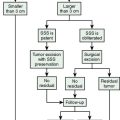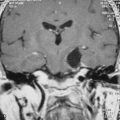CHAPTER 62 Emerging Surgical Techniques for the Treatment of Meningiomas
INTRAOPERATIVE IMAGING
Image-guided neurosurgery using a navigation system in the traditional operating room is important in the management of many meningiomas because it can localize the tumor and critical structures around it. Intraoperative imaging is a useful further development because it compensates for brain shift, allows accurate navigation, and gives verification of what has been done surgically before the patient leaves the operating room.1 Current intraoperative imaging modalities offering real-time imaging are computed tomography (CT), magnetic resonance imaging (MRI), and ultrasound. Other modalities may help define the tumor by cellular techniques—these include photodynamic imaging, radio immune imaging, and infrared imaging with ala or other material. These extend the capacity of the surgeon significantly but are not discussed here.
Brain shift may result from fluid shifts, reduction in tumor volume as the tumor is resected, changes in arterial pCO2, and cerebrospinal fluid (CSF) loss after opening of the dura.2–5 It makes guidance from preoperative images potentially and variably inaccurate. Intraoperative brain surface deformations greater than 10 mm have been documented within 1 hour of opening the dura. The error induced by this type of shift may be even larger in the presence of hydrocephalus or preexisting loss of parenchymal volume. Intra-operative imaging was in part created to overcome the effect of brain shifting.
CT in Intraoperative Imaging
CT has good tissue resolution but has traditionally been limited to uniplanar imaging and has the disadvantage of radiation of the patient and surgical team. As post-processing becomes more sophisticated and as radiation doses lessen, these may become less important. Lunsford and colleagues have extensive experience with CT in guiding tumor resection.6
Intraoperative Ultrasonography
Ultrasound is less expensive and less bulky than CT or MRI. It guides operative neurosurgery by differences in physical properties of the tumor and may show vasculature, which is quite helpful in larger meningiomas. Images may be difficult to interpret because echogenic structures may not reliably discern normal from abnormal tissue, and air bubbles or blood products in the surgical field may cause misinterpretation of ultrasound images.7–9 It is a potentially important modality, however, for working within the surgical field once it is exposed, and its importance for assessing residual tumor and vascularity in skull-base meningiomas has not been evaluated. As new three-dimensional systems become available, this may be the most widely available and useful technique for intraoperative imaging.7
Intraoperative MRI
Intraoperative MRI allows multiplanar imaging of changes during surgery, accurate navigation, immediate assessment of such complications as hemorrhage, and verification of the planned resection. The first system was the GE Signa 0.5 tesla “double doughnut” installed at Brigham & Women?’s Hospital (BWH) in 1994.1 The first brain tumor extirpation guided by intraoperative magnetic resonance was in 1996 at BWH. Multiplanar imaging, tissue discrimination, and absence of ionizing radiation have all contributed to the development of MRI as a tool for guiding interventional procedures, and there are more than 50 installations worldwide at the time of writing of this chapter.8–18 Imaging sequences such as MR spectroscopy, functional MR, diffusion-weighted imaging, perfusion weighted imaging, MR angiography, and MR venography, are all possible with high-field systems and can significantly influence the decision-making process of the neurosurgeon.
Factors contributing to high MR image quality for diagnostic purposes include the system field strength, field homogeneity, and stability of the static and gradient magnetic fields. The optimal design of a magnet with regard to field homogeneity would be a complete sphere, without opening. However, access to the patient is a prerequisite for surgery and monitoring. Design of intraoperative MR systems have advanced through compromises between opposing forces of field strength and surgical convenience and several systems have emerged from the close collaboration among surgeons, engineers, and industry. It is beyond the scope of this chapter to analyze the different intraoperative MR systems currently in use, and the reader is referred to descriptions in the recent literature. There are roughly two axes of interest; field strength, and movement of the patient. One classification is based on the magnet’s field strength; magnets can be described as low-field (0.12–0.15T), mid-field (0.3–0.5T), and high-field (1.5–3T). At present, low-field and mid-field systems have the advantage of providing greater patient access. High-field (1.5–3T) systems have restricted access to the patient during scanning, but offer higher resolution imaging. Examples of low-field systems are the GE Signa, the Hitachi 0.3 tesla system, and the Polestar 1.5 tesla system. These provide very comfortable patient access but imaging is not high resolution. In contrast, the high-field systems—Siemens Brain Suite, IMRIS system, and the Philips systems have more involved patient access.11–17
A second parameter is movement of the patient. Low-field systems tend to be more convenient—the GE system allowed surgery in the MR scanner; the Polestar is like an MR fluoroscope. Other systems require patient movement: for the Siemens system, into and out of the scanner by a rotating table, for the Philips movement of patient on a table. The IMRIS system brings the MR to the patient.11
Monitoring Complications
At the end of the procedure, a final imaging control can be performed in place to exclude immediate operative complications such as venous infarction hemorrhage, acute hydrocephalus, and stroke. The discovery of such an event provides the opportunity for immediate action and allows brain protection where it is needed. There may be a limitation in the interpretation of immediate postoperative imaging to distinguish remaining pathological tissue and operative edema. As experience accumulates and higher field strengths are used that permit adjunctive sequences, this limitation will be solved.19
HIGH-INTENSITY FOCUSED ULTRASOUND
High-intensity focused ultrasound (HIFU) is a technological advancement rising on the horizon of minimally invasive procedures. It allows target tissue destruction by thermal energy from multiple sources converging at one point. Tissue ablation can be achieved via a beam focused by spherically curved transducers, “phased array transducers,” that help to focus the beam on target tissue at different locations to minimize the defocusing effect of the skull; or by high-power reversal mirrors.20–22
Magnetic Resonance-Guided Focused Ultrasound
This procedure can target large lesions and produces a well circumscribed spherical affect, but the resultant tissue damage and cavitation is unpredictable, which limits its clinical use. There is also edema that culminates in 48 hours and diminishes within 7 days.23
INTERSTITIAL RADIOTHERAPY FOR MENINGIOMAS
Brachytherapy using chronically implanted is a potentially effective, minimally invasive treatment option for recurrent meningiomas. Traditionally, CT-guided microsurgery and stereotactic techniques are use to place radioactive material (I-125) into the meningioma. Catheters are inserted through stereotactic burr holes and iodine-125 seeds are implanted. The total dose that is given is in the range of 100 to 500 Gy delivered at a low dosage rate of 0.05 to 0.25 cGy/hr. Iridium-192 (Ir-192) can also be used: the dose is 60 Gy in 100 hours. Cold spots are produced at the implantation site that are seen on CT scan as nonenhancing hypodense rings.24,25
Along with reduction of volume of meningiomas, there may be improvement in signs of the involved cranial nerves. The trigeminal nerve is more sensitive to this sort of radiation and there may be facial numbness post therapy. Although brachytherapy is a safe procedure, catheter-related injury can occur to the third nerve in case of clival meningiomas, and catheter wound infection and CSF leak can occur. There may also be brain edema associated with this treatment, which can be reduced by using steroids.26
[1] Black P.M., Moriarty T., Alexander E.III, et al. Development and implementation of intraoperative magnetic resonance imaging and its neurosurgical applications. Neurosurgery. 1997;41:831-845.
[2] Hill D.L., Maurer C.R.Jr, Maciunas R.J., et al. Measurement of intraoperative brain surface deformation under a craniotomy. Neurosurgery. 1998;43:514-526.
[3] Nimsky C., Ganslandt O., Hastreiter P., Fahlbusch R. Intraoperative compensation for brain shift. Surg Neurol. 2001;56:357-364. discussion 364–5
[4] Nabavi A., Black P.M., Gering D.T., et al. Serial intraoperative magnetic resonance imaging of brain shift. Neurosurgery. 2001;48:787-797. discussion 797–8
[5] Reinges M.H.T., Nguyen H.H., Krings T., et al. Course of brain shift during microsurgical resection of supratentorial cerebral lesions: limits of conventional neuronavigation. Acta Neurochir (Wien). 2004;146:369-377.
[6] Engle D.J., Lunsford J.D. Brain tumor resection guided by intraoperative computed tomography. J Neuro-Oncol. 1987;4:361-370.
[7] Unsgaard G., Rygh O.M., Selbekk T., et al. Intra-operative 3D ultrasound in neurosurgery. Acta Neurochir (Wien). 2006;148:235-253. discussion 253
[8] Keles G.E., Lamborn K.R., Berger M.S. Coregistration accuracy and detection of brain shift using intraoperative sononavigation during resection of hemispheric tumors. Neurosurgery. 2003;53:556-562.
[9] Maurer M., Becker G., Wagner R., et al. Early postoperative transcranial sonography (TCS), CT, and MRI after resection of high grade glioma: evaluation of residual tumor and its influence on prognosis. Acta Neurochir (Wien). 2000;142:1089-1097.
[10] Foroglou N., Zamani A., Black P. Intraoperative MRI (iop-MR) for brain tumour surgery. Br J Neurosurg. 2009;23:14-22.
[11] Tronnier V.M., Wirtz C.R., Knauth M., et al. Intraoperative diagnostic and interventional magnetic resonance imaging in neurosurgery. Neurosurgery. 1997;40:891-902.
[12] Sutherland G.R., Kaibara T., Louw D., et al. A mobile high-field magnetic resonance system for neurosurgery. J Neurosurg. 1999;91:804-813.
[13] Hall W.A., Liu H., Martin A.J., et al. Safety, efficacy, and functionality of high-field strength interventional magnetic resonance imaging for neurosurgery. Neurosurgery. 2000;46:632-642.
[14] Chu R.M., Tummala R.P., Hall W.A. Intraoperative magnetic resonance image-guided neurosurgery. Neurosurg Q. 2003;13:234-250.
[15] Albayrak B., Samdani A.F., Black P.M. Intraoperative magnetic resonance imaging in neurosurgery. Acta Neurochir. 2004;146:543-557.
[16] Hadani M., Spiegelman R., Feldman Z., et al. Novel, compact, intraoperative magnetic resonance imaging-guided system for conventional neurosurgical operating rooms. Neurosurgery. 2001;48:799-807.
[17] Matsumae M., Koizumi J., Fukuyama H., et al. World’s first magnetic resonance imaging/x-ray/operating room suite: a significant milestone in the improvement of neurosurgical diagnosis and treatment. J Neurosurg. 2007;107:266-273.
[18] Bernstein M., Al-Anazi A.R., Kucharczyk W., et al. Brain tumor surgery with the Toronto open magnetic resonance imaging system: preliminary results for 36 patients and analysis of advantages, disadvantages, and future prospects. Neurosurgery. 2000;46:900-907.
[19] Schwartz R.B., Hsu L., Wong T.Z., et al. Intraoperative MR imaging guidance for intracranial neurosurgery: experience with the first 200 cases. Radiology. 1999;211:477-488.
[20] Cohen Z.R., Zaubermann J., Harnof S., et al. Magnetic resonance image guided focused ultrasound for thermal ablation in brain; a feasibility study in a swine model. Neurosurgery. 2007;60:593-600. discussion 600
[21] Patrick J.T., Nolting M.N., Gross S.A., et al. Ultrasound and blood brain barrier. Adv Exp Med Biol. 1990;267:369-381.
[22] Sokka S.D., King R., Hynynen K. MRI-guided gas bubble enhanced ultrasound heating in vivo rabbit thigh. Phys Med Biol. 2003;48:223-241.
[23] Morocz I.A., Hynynen K., Gudbjartsson H., et al. Brain edema development after MRI-guided focused ultrasound treatment. J Magn Reson Imaging. 1998;8:136-142.
[24] Kumar P.P., Patil A.A., Syh H.W., et al. Role of brachytherapy in management of skull base meningiomas. J Natl Med Assoc. 1993;85:369-374.
[25] Vuorinen V., Heikkonen J., Brander A., et al. Interstitial radiotherapy of 25 parasellar/clival meningiomas and 19 meningiomas in the elderly. Analysis of short-term tolerance and responses. Acta Neurochir (Wein). 1996;138:459-508.
[26] Obasci P.C., Barnett G.H., Suh J.H. Brachytherapy for intracranial meningioma using permanently implanted iodine-125 seeds. Stereotact Funct Neurosurg. 2007;7:33-43.







